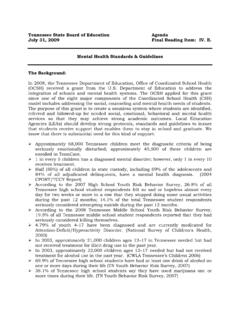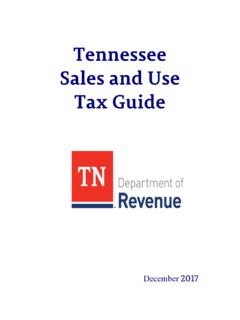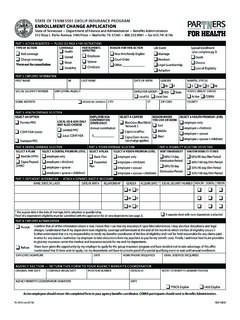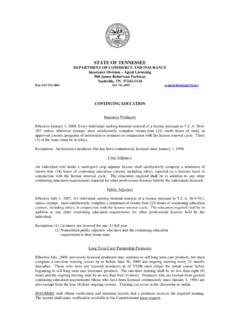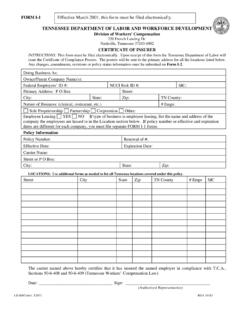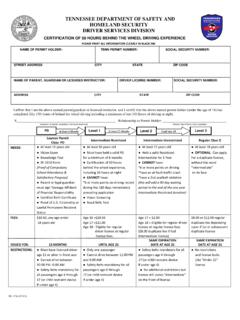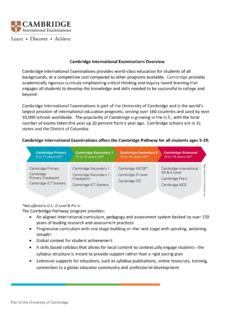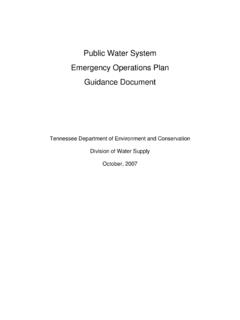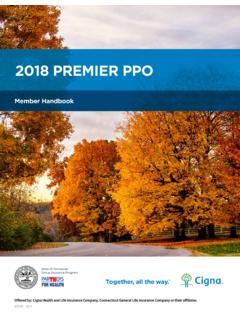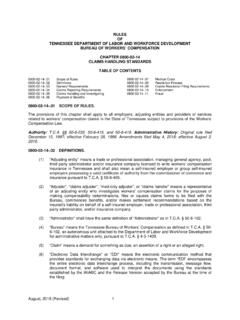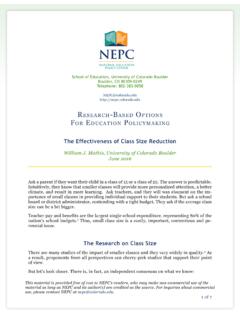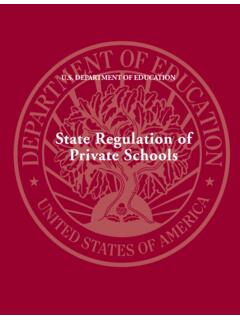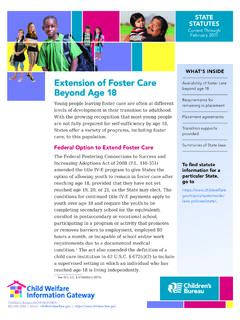Transcription of Bill Breakdown The Tennessee Investment in Student ...
1 Bill Breakdown The Tennessee Investment in Student Achievement (TISA). Developing The Bill Governor Lee announced a review of the Basic Education Program, or BEP. The Department of Education launched an extensive, months-long public engagement process. It entailed town hall meetings statewide, online live chats, phone calls, emails and more This process built on almost two decades of discussion through BEP. Review Committees and a yearlong taskforce in 2014. Three Decades of Funding 2021. Robust Public Engagement Reform Discussion Begins 2014. BEP Reviewed by Gov. Haslam's task force 2022. New Formula Proposed 1992. Basic Education Program (BEP) Created 2016. BEP Modified Slightly Again 2007. BEP Modified Slightly 1000s of public comments representing Tennesseans across the state Input channeled to subcommittees 18.
2 Made up of district and school leaders, higher education partners, elected officials, business leaders, families, education stakeholders and members of the public Subcommittees developed recommendations for the Tennessee Investment in Student Achievement (TISA). formula using public comments Funding review subcommittees A steering committee of state officials discussed recommendations and provided feedback and guidance to the department 2022. February The General Assembly will begin considering the Tennessee Investment in Student Achievement. Potential Next Steps 1 Bill is introduced 2 Bill is heard and discussed in at least 7 committees 3 Bill is voted on by the Senate and House 4 Bill is signed by governor, if passed 5 Bill becomes law Tennessee Investment in Student Achievement is designed Empower each Student to read proficiently by third grade.
3 Prepare each high school graduate to succeed in the postsecondary program or career of the graduate's choice. Provide each Student with the resources needed to succeed, regardless of the Student 's individual circumstances. Formula Breakdown Overall Funding Landscape $ 1B. $9B in new recurring state funds ($250M FY23 and $750M FY24). in total education 750M. funding for 2024. (state and local). $. in one-time state funds in FY23. Framework of A Student -based Formula Base + Weights + Direct + Outcomes Outcomes Funding Incentivizes Student achievement and education Direct Funding excellence Offers students learning opportunities beyond everyday classroom Weights instruction Provides additional funds for students with unique learning needs or who may Base need additional supports Covers the essentials each Student needs for a K-12.
4 Education Overview: Base Funding Existing funding was maintained and strengthened. $ allocated to the Additional funding available for teacher salaries, nurses, counselors, principals, RTI2, technology Funds school support staff so teachers are base empowered to concentrate more on academic instruction Empowers Tennessee to recruit out-of-state teachers and grow the in-state teacher workforce Overview: Weight Funding Economically Disadvantaged and Concentration of Poverty $ allocated to Sparse and Small Unique learning needs, including: Students with disabilities and gifted students, weights English learners, and students with characteristics of dyslexia Students with multiple learning needs can receive additional funding for each need Charter school facilities in the same amount that is currently funded Supporting Students' Individual Needs TISA would provide funds for the $6,860 BASE plus: Economically disadvantaged students Base x 25% 322,073 students Students living in areas of concentrated poverty Base x 5% 652,039 students Students in sparsely populated communities and students in small districts Base x 5% 326,549 students Students with unique learning needs 288,072 services Base x ULN% (students may generate up to Range: 15% - 150% 4 services).
5 Overview: Direct Funding Supports programs that offer students learning opportunities beyond everyday classroom instruction $376M. allocated to direct $145 million to enhance K-3rd grade literacy $8 million to offer literacy tutoring to 4th graders who need more support funding $210+ million to support career and technical education $13 million to fund post-secondary assessments (ACT and ACT Retake). Breaking it Down: Direct Funding TISA would provide districts additional funds to: Enhance literacy supports for K-3 students $500 per K-3 Student 288,862 students Offer literacy tutoring to students who need more help $500 per Student 15,737 students Strengthen and expand high-value career and technical education offerings $5,000 avg. per Student 42,064 students Pay for two administrations of a post-secondary assessment.
6 $185 per Student 69,894 students Overview: Outcomes Funding Awards per- Student bonuses when students demonstrate success in learning to read and college and career readiness. $100M Awards per- Student outcomes funding for students who are on-grade level in reading at the end of 3rd grade, with additional funding for students who are economically disadvantaged. allocated to outcomes funding components Awards per- Student outcomes funding when students achieve college and career ready benchmarks of either ACT performance or improvement , or earning a Tier II or Tier III. industry credential. Additional funding awarded for economically disadvantaged students and those who enroll in college or directly enter the workforce in CTE field. Example Elementary Students Characteristic Eligible?
7 Value Characteristic Eligible? Value Base $6,860 Base $6,860. Economically Disadvantaged Economically Disadvantaged Base x 25%. Concentration of Poverty Concentration of Poverty Base x 5%. Sparse Sparse Base x 5%. Small Small Base x 5%. Charter Charter Unique Learning Need Base x 20% Unique Learning Need Base x 60%. K 3rd Grade Student $500 Base x 20%. Student 1 Student 2 K 3rd Grade Student 4th Grade Tutoring CCTE 4th Grade Tutoring $500. Post-Secondary Assessment CCTE. Post-Secondary Assessment TOTAL FUNDING: $8,732 TOTAL FUNDING: $15,592. Example Middle school Students Characteristic Eligible? Value Characteristic Eligible? Value Base $6,860 Base $6,860. Economically Disadvantaged Economically Disadvantaged Concentration of Poverty Concentration of Poverty Sparse Sparse Base x 5%.
8 Small Small Charter Charter Unique Learning Need Base x 70% Unique Learning Need K 3rd Grade Student K 3rd Grade Student Student 1 Student 2. 4th Grade Tutoring 4th Grade Tutoring CCTE CCTE $4,500. Post-Secondary Assessment Post-Secondary Assessment TOTAL FUNDING: $11,662 TOTAL FUNDING: $11,703. Example High school Students Characteristic Eligible? Value Characteristic Eligible? Value Base $6,860 Base $6,860. Economically Disadvantaged Base x 25% Economically Disadvantaged Concentration of Poverty Base x 5% Concentration of Poverty Sparse Sparse Base x 5%. Small Small Charter Charter Unique Learning Need Base x 40% Unique Learning Need Student 5 Student 6. K 3rd Grade Student K 3rd Grade Student 4th Grade Tutoring 4th Grade Tutoring CCTE $6,000 CCTE $4,000.
9 Post-Secondary Assessment $185 Post-Secondary Assessment $185. TOTAL FUNDING: $17,847 TOTAL FUNDING: $11,388. Other Education Funding: Fast-Growing Fast-Growing Student Stipend LEAs with current-year growth above 2% from the prior year will receive same-year funding for the additional students. Fast Growing Infrastructure Stipend LEAs with 2% growth each year for three consecutive years may also receive an infrastructure stipend with remaining funds. Supporting Teachers Funds school support staff so teachers can concentrate on academic instruction. $125M. Provides for the Governor and General Assembly to direct education funding increases to go to raises for existing teachers. to increase public school teachers'. salaries in FY23, which will carry- Requires increases in education funding over to the TISA base for salaries to also trigger increases to state minimum salaries, which is on-track to increase the state minimum salary $10k from $35,000 in Jan 2019 to $45,000 by 2026.
10 Bill Breakdown Local Contribution &. Fiscal Capacity State and local share is split 70/30 for the base and weights only. The state will cover direct funding, outcomes and fast-growing. Fiscal capacity will be established by CBER, evaluated by the Comptroller of the Treasury, and approved by the State Board each year. The department will provide grants to help distressed and at-risk counties, and those with special circumstances related to maintenance of effort (MOE). Local contributions are set to be lower in FY24, FY25, and FY26 and begin to increase again in FY27, in an amount similar to prior years so that the new state Investment does not overwhelm local requirements. No changes to MOE. Improving Transparency and Accountability school Boards Must establish academic goals that the local budget is intended to support Must describe the results and return on Investment of the prior year strategy Districts and Public Charter Schools An LEA or public charter school with a D or F.
